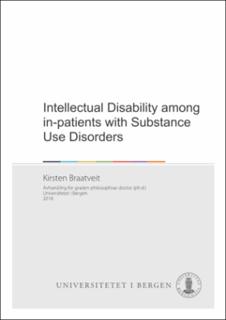| dc.contributor.author | Braatveit, Kirsten | |
| dc.date.accessioned | 2018-11-26T11:02:10Z | |
| dc.date.available | 2018-11-26T11:02:10Z | |
| dc.date.issued | 2018-10-26 | |
| dc.identifier.isbn | 978-82-308-3645-3 | |
| dc.identifier.uri | https://hdl.handle.net/1956/18737 | |
| dc.description.abstract | Background: Knowledge about the comorbidity of substance use disorder (SUD) and intellectual disabilities (ID) or borderline intellectual functioning is growing. However, most of the knowledge about the comorbidity of ID and SUD comes from studies conducted in ID services. The current knowledge about the prevalence of ID, characteristics, substance use profiles, and responses to treatment of individuals with ID in SUD treatment is limited. Several factors complicate the identification and diagnostic process when assessing ID in individuals with SUD. This PhD project investigates the comorbidity of ID and SUD in mainstream in-patient treatment for SUD. It examines prevalence and characteristics of ID as well as interpretation of test results and means of early ID identification. Aims: Paper I. To investigate the direct effects of five areas of pre- substance-use childhood difficulties on IQ and their possible indirect effect through the mediating variables of education and severity of substance use. Paper II. To investigate the prevalence of ID and borderline intellectual disability (BID) in a population of in-patients with SUD and to explore similarities and differences between ID/BID and non-ID among SUD in-patients with regard to education, previous contact with public support systems, childhood learning difficulties, comorbid mental disorders and substance-related factors. Paper III: To validate the ability of the Hayes Ability Screening Index (HASI) to predict ID in in-patients with SUD. Method: The project featured a retrospective, cross sectional design. In total, 94 participants were recruited from three in-patient treatment facilities for SUD. SUD and mental illness were diagnosed using the criteria from the10th version of the International Classification of Diseases (ICD-10). Intelligence was measured using the fourth version of the Wechsler Adult Intelligence scale (WAIS-IV). Adaptive behavior was measured using the second edition of the Vineland Adaptive Behavioral Scale (Vineland II). Childhood difficulties, previous contact with support services, substance use and educational history were assessed using a self-report questionnaire. The HASI was used as a screening instrument for ID. Interrater reliability coefficients were calculated for the administrators of the WAIS-IV and the HASI. Results: Mediator model of childhood difficulties and IQ. In Paper I, the variance in intelligence coefficient (IQ) was found to be related to childhood difficulties alone or through the mediator of education. IQ did not significantly differ between participants who used different substances, and the severity of substance use did not influence IQ in any of the five models tested. Prevalence of ID/BID. In Paper II, the prevalence of ID/BID was found to be about 30% (ID: 7.7%, BID: 24.2%). Only one participant was identified with a developmental disorder by the treating institution. Statistically significant differences were found between the ID/BID group and non-ID group with regard to length of education, previous contact with public support systems, and self-reported childhood learning difficulties. There were no statistically significant differences between the groups concerning substance-related factors, except for substance-use relapse during treatment. Validity of HASI. The results of Paper III showed a statistically significant positive correlation between both measures of IQ and adaptive skills and the HASI. The discriminant validity analysis showed that HASI had a sensitivity of 100% and a specificity of 65.4% in identifying individuals with ID at the original adult cut-off score of 85. Among the subjects falsely identified with ID, 76.2% fulfilled the criteria defined for BID. Conclusion: The results in this PhD project indicate that a significant number of individuals in mainstream SUD in-patient treatment may meet the criteria for ID/BID. They also imply that these individuals are not identified with a developmental disorder during childhood or the treatment period. The findings support a hypothesis that signs of ID/BID in in-patients with SUD can most likely be attributed to pre-morbid functioning. Finally, the results indicate that the HASI may be a useful instrument for broad screening of the SUD in-patient population and selection of individuals for further ID assessment. The findings have theoretical as well as clinical implications and provide new knowledge on the comorbidity of ID and SUD with its unique contribution from mainstream SUD in-patient treatment. | en_US |
| dc.language.iso | eng | eng |
| dc.publisher | The University of Bergen | eng |
| dc.relation.haspart | Paper I: Braatveit, K., Torsheim, T., & Hove, O. (2018). Intellectual functioning in inpatients with substance use disorders: Preliminary results from a clinical mediation study of factors contributing to IQ variance. European Addiction Research, 24(1), 19–27. The article is not available in BORA due to publisher restrictions. The published version is available at: <a href="https://doi.org/10.1159/000486620" target="blank"> https://doi.org/10.1159/000486620</a> | eng |
| dc.relation.haspart | Paper II: Braatveit, K., Torsheim, T., & Hove, O. (2018). The prevalence and characteristics of intellectual and borderline intellectual disabilities in a sample of inpatients with substance use disorders: Preliminary clinical results. Journal of Mental Health Research in Intellectual Disabilities, 11(3), 203–220. The article is not available in BORA due to publisher restrictions. The published version is available at: <a href=" https://doi.org/10.1080/19315864.2018.1469701" target="blank"> https://doi.org/10.1080/19315864.2018.1469701</a> | eng |
| dc.relation.haspart | Paper III: Braatveit, K., Torsheim, T., & Hove, O. (2018). Screening for intellectual disabilities: a validation of the Hayes ability screening index for in-patients with substance use disorder. Nordic Journal of Psychiatry, 72(5), 387–392. The article is not available in BORA due to publisher restrictions. The published version is available at: <a href=" https://doi.org/10.1080/08039488.2018.1468923" target="blank"> https://doi.org/10.1080/08039488.2018.1468923</a> | eng |
| dc.title | Intellectual Disability among in-patients with Substance Use Disorders | eng |
| dc.type | Doctoral thesis | |
| dc.rights.holder | Copyright the author. All rights reserved | eng |
| dc.identifier.cristin | 1620974 | |
